If level-3 pandemic countermeasures have dampened the economy, it wasn’t obvious from the non-stop parade of trucks on Freeway 1 just after six o’clock on a weekday morning.
I’d cycled under the interchange between Freeway 1 and Freeway 8 in Tainan’s Sinshih District (新市), using a bike trail that’s part of the Mountains to Sea National Greenway (山海圳國家級綠道). This 177km-long route knits together long-established hiking trails, conventional roads and purpose-built cycling and walking paths to connect the Taiwan Strait with the 3,952m-high summit of Jade Mountain (玉山).
By comparison, my own ambitions were modest. During level 3, in fits and starts, I’d been working out the best way for an engineless two-wheeler to get from lakeside to seaside.
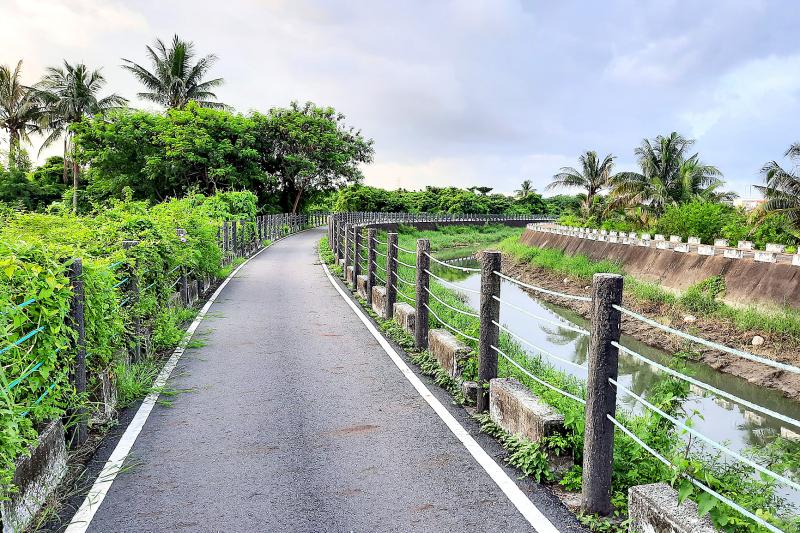
Photo: Steven Crook
The body of water where I began isn’t famous. Yingsi Lake (迎曦湖) is a manmade feature in the Tainan section of Southern Taiwan Science Park (南部科學工業園區). Designed to mitigate flooding and stabilize water supplies, the lake is 520m in length and about 20m across.
A huge piece of art dominates the lake’s northwestern corner. The Yellow Ribbon (舞彩迎賓 — the Chinese name means something like “a dancing and colorful greeting”) is a 440m-long steel canopy that undulates across the landscape. Usually I’m no fan of this kind of thing, but I think the giant billowing ribbon does add something to the scenery.
From Yingsi Lake, I rode northwest on Tainan Local Road 134 to another of the science park’s flood-detention basins.
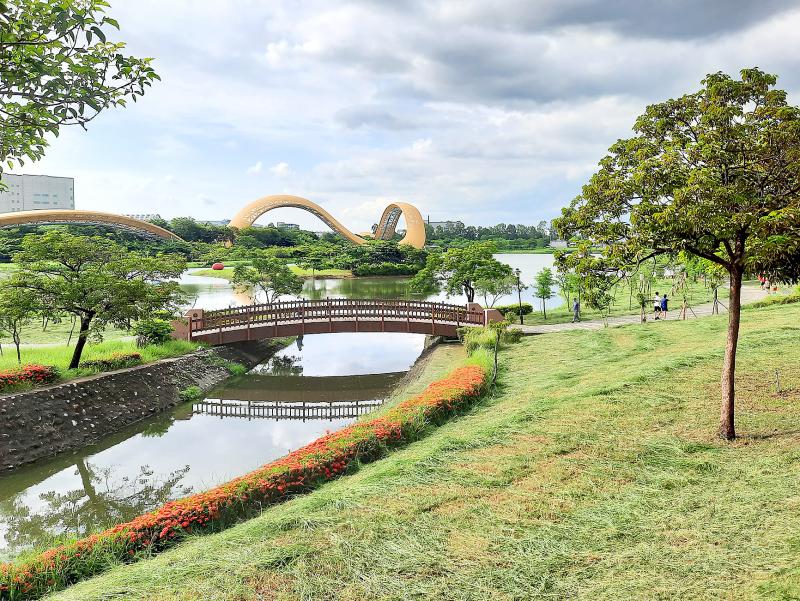
Photo: Steven Crook
Ditang Lake (堤塘湖) is slightly smaller than Yingsi Lake, and not quite so appealing. I half expected the entrance to the bike path, right across the road from the lake’s southern shore, to be cordoned off with yellow tape. It wasn’t, likely because some people use it to commute to their jobs in the science park.
LINKING MOUNTAINS AND SEA
The Mountains to Sea National Greenway (which some bilingual signboards call the Green Connection of Hillside, Coast and Irrigation) is divided into 31 numbered segments. MSTW04 links Ditang Lake with the National Museum of Taiwan History (國立臺灣歷史博物館) in Annan District (安南). On the day of my ride, the museum was closed because of the lockdown.
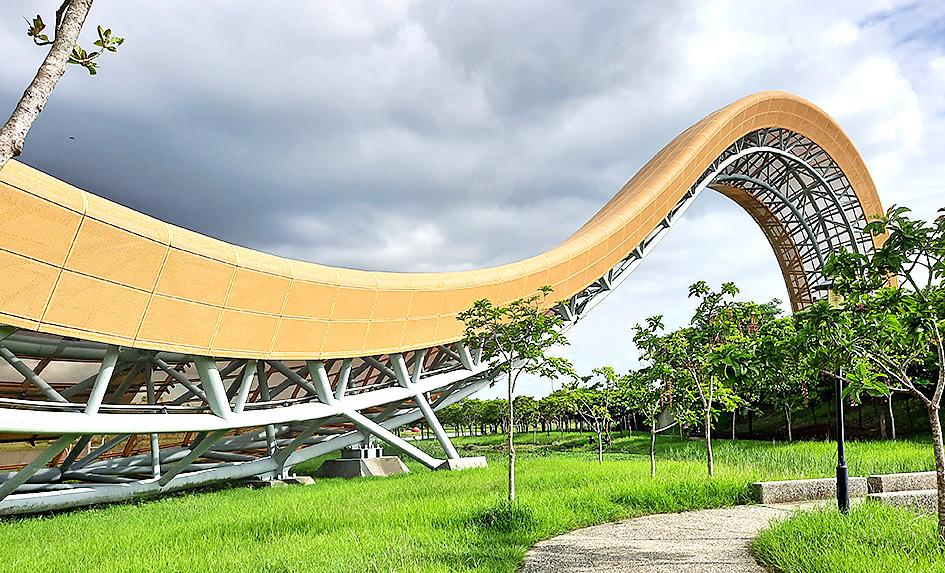
Photo: Steven Crook
Along most but not all of MSTW04, cyclists are kept separate from cars and motorcycles. Before reaching the museum, I veered off MSTW04 and took Huankuan Road (環館路), then a succession of minor roads. Working my way north, I joined Provincial Highway 19 just before it passes beneath Freeway 8.
The highway is busy at the best of times, and in the morning rush hour it was no fun. But it took me where I wanted to go: Over the Tsengwen River (曾文溪) — swollen due to a fortnight of heavy rain — and into Sigang District (西港).
Riding on the levee that separates the town from the river, I came across a simple concrete obelisk.
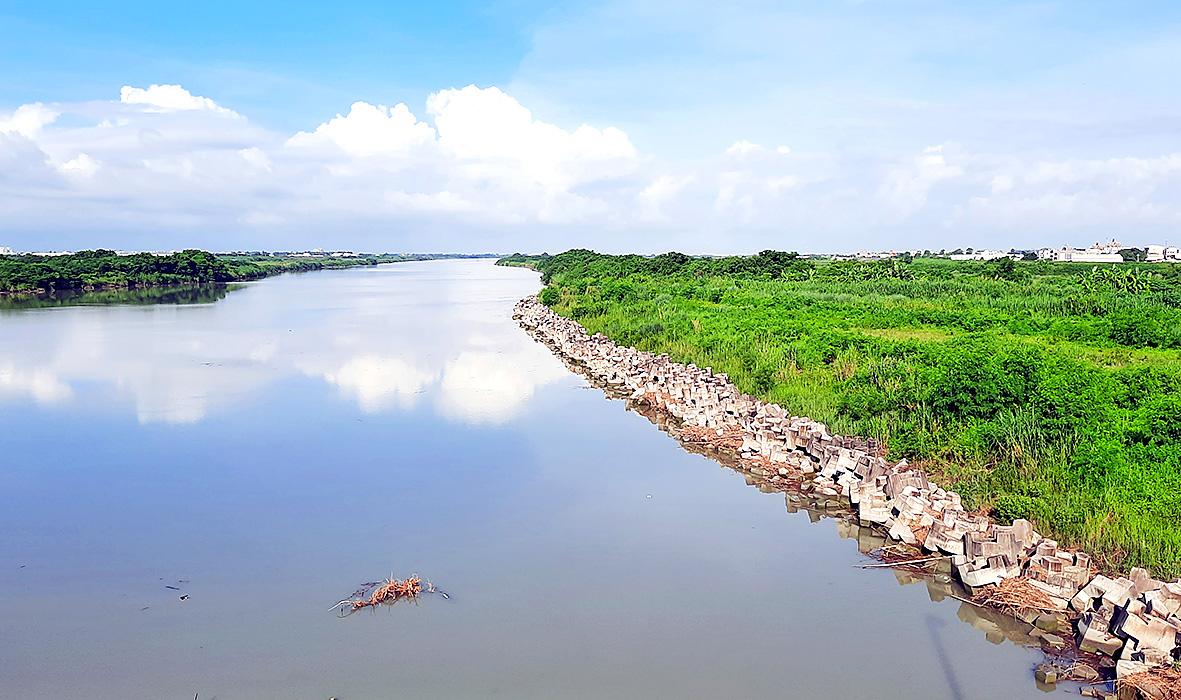
Photo: Steven Crook
The Tsengwen River Water Control Monument (曾文溪治水紀念碑) faces the river, and celebrates humanity’s efforts to control this unruly waterway. Its long history of breaking its banks and suddenly changing course came to end in 1938, when the Japanese colonial authorities then ruling Taiwan completed a multi-year project to keep the river in its place.
Realizing at least 20km lay between me and the coast, and that there’d be precious little shade, I made a decision. Looping back toward Provincial Highway 19, I began the ride home. Finishing my own project would have to wait for another day.
TO THE LIGHTHOUSE
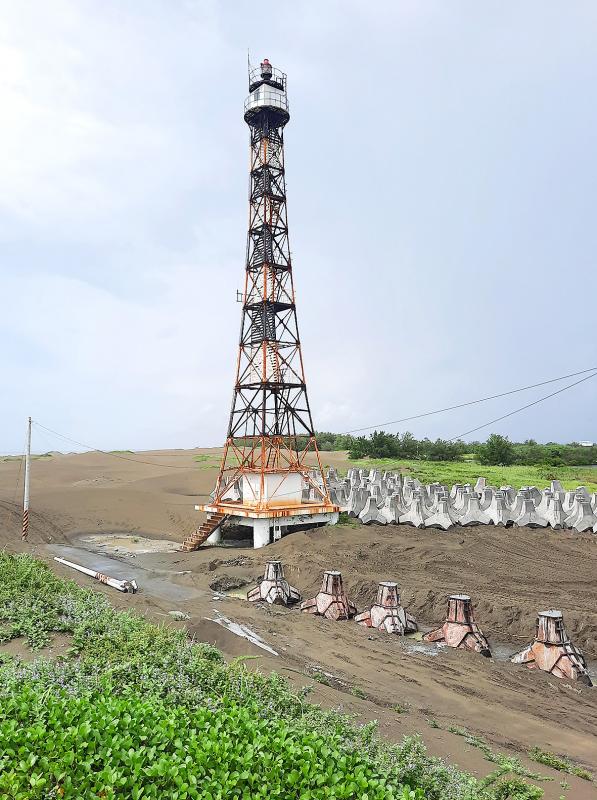
Photo: Steven Crook
As it happened, I ended up driving to the point on the coast that I’d hoped to reach by bicycle.
On a day that alternated between short but intense showers and burning sunshine, I skirted the part of Taijiang National Park (台江國家公園) that’s famous for hosting Black-faced spoonbills and other migratory waterbirds, then followed the coast north to Kuosheng Lighthouse (國聖燈塔). A neverending concrete embankment means visitors can’t see anything of the Taiwan Strait unless they leave their vehicles and scramble to the top of the barrier.
I drove until I ran out of sealed road, less than 50m south of the lighthouse. At first glance (and second inspection), this piece of infrastructure left me underwhelmed. A 32.7m-high unmanned beacon, it looks a bit like a water tower.
The first version of Kuosheng Lighthouse was built in 1957. Toppled by a typhoon in 1989, it was quickly reconstructed. Its claim to fame has nothing to do with its history or design. Rather, it stands on the most westerly dry land on Taiwan proper.
From the embankment, there are more interesting sights than the lighthouse. Not only could I gaze at a desolate expanse of beach, but to the north, part of Dingtoue Sandbar (頂頭額沙洲) was visible.
Like all such features, the sandbar’s size and shape are in constant flux. Recent satellite photos suggest it’s at least as big as Taipei’s Daan Forest Park (大安森林公園).
Some people visit the sandbar late in the afternoon to appreciate the sunset. Admission is free. Watersports are prohibited, and vehicles shouldn’t enter. However, tire tracks in the wet sand suggested at least one off-roader had driven onto the sandbar not long before I arrived.
Not having enough time to explore the sandbar, I decided to take photos of the wildflowers that thrived on the seawall despite the lack of soil and the salt-bearing winds.
There were thousands of them, all of the same species. I later discovered this type of plant is called beach vitex, Vitex rotundifolia, or Haipujiang (海埔姜).
It’s by no means rare and, like many other plants in Taiwan, it’s claimed to have a medicinal function. Some people boil its fruit and leaves with water to make a kind of tea that’s said to reduce fevers.
I still hope to ride all the way from Yingsi Lake to Kuosheng Lighthouse. But even if beach vitex is a surefire cure for heat stroke, I won’t attempt it until well after summer’s end.
Steven Crook has been writing about travel, culture and business in Taiwan since 1996. He is the author of Taiwan: The Bradt Travel Guide and co-author of A Culinary History of Taipei: Beyond Pork and Ponlai.

On April 26, The Lancet published a letter from two doctors at Taichung-based China Medical University Hospital (CMUH) warning that “Taiwan’s Health Care System is on the Brink of Collapse.” The authors said that “Years of policy inaction and mismanagement of resources have led to the National Health Insurance system operating under unsustainable conditions.” The pushback was immediate. Errors in the paper were quickly identified and publicized, to discredit the authors (the hospital apologized). CNA reported that CMUH said the letter described Taiwan in 2021 as having 62 nurses per 10,000 people, when the correct number was 78 nurses per 10,000

As we live longer, our risk of cognitive impairment is increasing. How can we delay the onset of symptoms? Do we have to give up every indulgence or can small changes make a difference? We asked neurologists for tips on how to keep our brains healthy for life. TAKE CARE OF YOUR HEALTH “All of the sensible things that apply to bodily health apply to brain health,” says Suzanne O’Sullivan, a consultant in neurology at the National Hospital for Neurology and Neurosurgery in London, and the author of The Age of Diagnosis. “When you’re 20, you can get away with absolute

May 5 to May 11 What started out as friction between Taiwanese students at Taichung First High School and a Japanese head cook escalated dramatically over the first two weeks of May 1927. It began on April 30 when the cook’s wife knew that lotus starch used in that night’s dinner had rat feces in it, but failed to inform staff until the meal was already prepared. The students believed that her silence was intentional, and filed a complaint. The school’s Japanese administrators sided with the cook’s family, dismissing the students as troublemakers and clamping down on their freedoms — with

As Donald Trump’s executive order in March led to the shuttering of Voice of America (VOA) — the global broadcaster whose roots date back to the fight against Nazi propaganda — he quickly attracted support from figures not used to aligning themselves with any US administration. Trump had ordered the US Agency for Global Media, the federal agency that funds VOA and other groups promoting independent journalism overseas, to be “eliminated to the maximum extent consistent with applicable law.” The decision suddenly halted programming in 49 languages to more than 425 million people. In Moscow, Margarita Simonyan, the hardline editor-in-chief of the